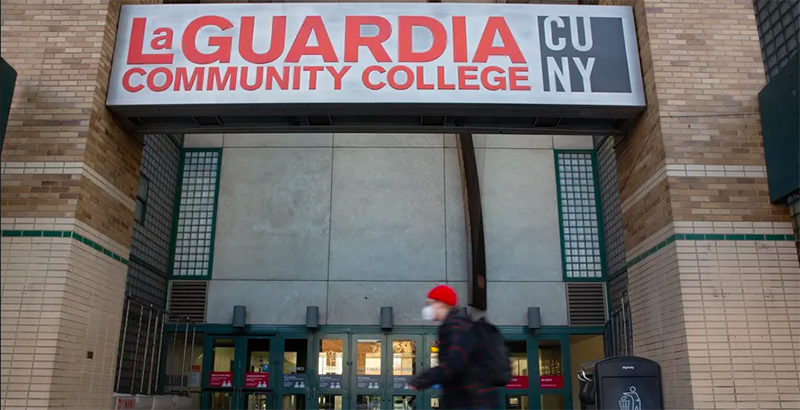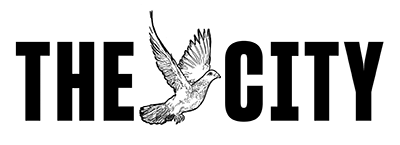CUNY Community Colleges Contend With Plunging Enrollment

Get stories like this delivered straight to your inbox. Sign up for The 74 Newsletter
This article was originally published on by THE CITY.
Brissbany Herrera sailed through her first semester at LaGuardia Community College in fall 2019, the first in her family of Peruvian immigrants to pursue higher education.
But midway through the Queens school’s spring semester in 2020, the pandemic knocked her off course — in addition to many of her neighbors in Elmhurst, a COVID-19 epicenter.
“I didn’t have internet,” said Herrera, 20, noting how her family couldn’t afford it when her classes moved online. “And I couldn’t find any way to attend.”
She immediately dropped out, she said. Meanwhile, her parents became infected with coronavirus and lost their jobs in construction and housekeeping. After they recovered and found stable employment again, Herrera opted to work as a home health aide instead of returning to college, while saving up to stage a comeback.
“I want to go back to college now,” Herrera told THE CITY, although she has yet to enroll at LaGuardia, which begins its new semester March 5.
As most of CUNY kicks off the spring semester, some of its campuses are continuing a steep decline in student enrollment that coincided with the pandemic.
The enrollment plunge has been most striking at the public university system’s seven community colleges — mirroring a troubling national trend.
Faculty, school leaders and higher ed observers point to a pile-on of forces pushing numbers down, including thin guidance counseling during remote high school, CUNY’s push for in-person classes when many students sought online courses, and would-be students joining the workforce.
Enrollment dropped 13.2% at the community colleges in January 2022 compared to a year prior, according to a snapshot of CUNY student data obtained by THE CITY. The data shows all but Kingsborough Community College in Brooklyn suffered a drop in students.
Leading the decline was LaGuardia, which had 6,347 students as of Jan. 23 — a drop of 34% from the 9,673 students there at the same point in 2021, the data shows.
Across the country, undergraduate enrollment declined by 6.6% — more than 1 million students — from fall 2019 to fall 2021, according to the National Student Clearinghouse Research Center. Colleges and universities in New York state account for 10% of that drop, a Forbes analysis found.
CUNY, recognized as a leading engine of economic mobility in the nation, enrolled 271,242 students in the fall 2019 semester, 91,715 of them at community colleges. A year later that fell to 261,134 students, including 69,323 at community colleges.
CUNY says it doesn’t have official fall 2021 enrollment numbers to share yet.
‘Trying to Hold the Line’
At LaGuardia, where many students hail from Queens neighborhoods disproportionately affected by the pandemic, enrollment has dropped nearly a quarter since 2019.
“We’re trying to hold the line and maintain our enrollment at the level from the fall,” Kenneth Adams, president of LaGuardia, told THE CITY.
The Long Island City-based college enrolled 12,187 students in the fall semester of 2021, down 23% from 15,836 in the last pre-pandemic semester in the fall of 2019.
“Our hope is that we’ve kind of reached the bottom and we’re going to start to rebuild and build up,” Adams added.
He said a major part of the school’s strategy to attract students involves raising money — on top of $10 million in donations already collected in the past several months — to help those in need.
“We have introduced a number of new scholarships, emergency aid programs, rental assistance,” he said. “We have gift cards that we give you and we load them up so you can order food delivered to your house through FreshDirect.”

The decline of enrollment in the city’s community colleges runs contrary to what happens historically when an economic catastrophe causes massive job losses, said Paul Attewell of the CUNY Graduate Center, who studies inequity in higher education and recently wrote a research paper titled “Where Have All The Students Gone?”
“Normally, when loads of people lose their jobs, the numbers of enrollment in community colleges and four-year colleges go up,” he said. “The people shelter by going into higher ed. That’s not what happened this time.”
Crunching data from the Office of Institutional Research at CUNY, Attewell found the number of college freshmen declined by 11% from the fall of 2019 to the fall of 2020. The dropoff was steepest among men, whose enrollment declined by 17.7%.
Adams acknowledged a plunge among first-year students at LaGuardia. “We’re seeing a real, very significant fall off in new freshmen,” he said.
Attewell said remote learning in New York City high schools likely led to fewer students being around the peer pressure of collegebound classmates and advisors asking about their future plans, or checking to see they filled out their student financial aid forms known as FAFSA.
“Students who weren’t super motivated to begin with, or super savvy about what they needed to do to go to college, were probably disrupted more than others,” he said.
Fewer Students = Fewer Teachers Needed
The decline in enrollment has also been distressing for faculty members, said Lara Beaty, co-director of the psychology program and chair of the faculty union chapter at LaGuardia. She said the fall semester experienced more than 100 class cancellations.
“This particularly affects our adjuncts, many of whom have lost jobs and lost health insurance,” Beaty said.
Beaty, who researches adverse childhood experiences on student development, said the pandemic disruptions in education have been difficult for many of her students.
“A lot of them are stressed or even traumatized by everything that’s going on,” she said. “And it is making it harder for students and faculty alike to function, and the shifting from whether we’re going to be in person or online complicates it all the more.”

CUNY set a target of 70% in-person classes prior to the recent surge of omicron, but recently granted flexibility to individual campuses in setting their own targets, after faculty and union leaders complained that many online courses were overflowing out while in-person classes couldn’t attract enough students.
Beaty said she is worried about the community college enrollment decline, which began to fall pre-COVID but plummeted even further during the pandemic.
“The state of community colleges, and of the people that we serve, is very precarious right now, everything from jobs being less stable, the sort of gig economy that we have,” she said. That instability, she continued, “makes it a whole lot harder for students.”
“I cannot say I’m optimistic,” she said. “I’m trying to not be pessimistic either. But I think there’s some changes coming, and we need to figure out how to address them.”
James Davis, president of the Professional Staff Congress, representing some 30,000 faculty and staff members at CUNY, said his union is trying to ensure that faculty jobs aren’t lost when CUNY reflexively attempts to cancel classes with low enrollment.
“If enrollment isn’t strong in a class, they can technically cancel it right up until the last minute,” said Davis, who is also a professor of English at Brooklyn College. “And since so many of our faculty are on contingent appointments, and are not full time, it leaves at least those faculty members vulnerable to that kind of management.”
Full-time faculty taught 41.5% of undergrads in the 2019-2020 academic year, according to CUNY’s most recent Performance Management Process report.
The effects of class cancellation extend to students as well, he said. “It’s just destabilizing, and it forces them into yet another set of challenges that they don’t really need in their academic career,” he said.
Davis added that if LaGuardia “doesn’t make some adjustments, they’re facing some really tough challenges to class cancellations, too.”
Relying on Federal Dollars for Now
Adams noted the decline in enrollment translates to a decline in revenue, but that federal stimulus funds are covering the losses in the current fiscal year ending in June. Going forward, he said, he worries about the next year.
“There will not be any more federal stimulus money to plug that hole,” he said.
Adams said he is also worried about the next generation of young people.
“If they’re not at work, and they’re not in school, and they’re not coming to CUNY, where are they? What are they doing?” he said.
In Herrera’s case, at least, she’s working but taking steps to return to LaGuardia.
A recent high school graduate when she enrolled in LaGuardia in 2019, she said she plans to study nursing, graduate, become independent and find a job earning enough to support her parents who sacrificed so she could have a better life in New York City.
“I want to make them proud of me,” she said.
THE CITY is an independent, nonprofit news outlet dedicated to hard-hitting reporting that serves the people of New York.
Get stories like these delivered straight to your inbox. Sign up for The 74 Newsletter

;)
